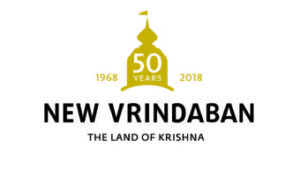New Vrindaban – The Land of Krishna
By Madhava Smullen for ISKCON New Vrindaban Communications
Archival Research by Chaitanya Mangala Dasa
In the early 1960s, A.C. Bhaktivedanta Swami Prabhupada, the founder of the Hare Krishna Movement, was a simple Swami living in the village of Vrindavan, in Uttar Pradesh, India.
Vrindavan, the land where five thousand years ago Lord Krishna grew up tending cows, is one of the most revered places in India and is central to practitioners of Gaudiya Vaishnavism.
Prabhupada’s life there was peaceful – retired from family life, he stayed in a spartan room in the Radha Damodar temple, translating ancient Vedic texts. He could have remained there, living a stress-free existence.
But his mind was set on the instruction his guru, Srila Bhaktisiddhanta Sarasvati, had given him back in 1922: to bring the teachings of bhakti-yoga, or Krishna consciousness, to the English-speaking world.
So Prabhupada left Vrindavan to bring Vrindavan to the world. In 1965, at the age of sixty-nine, he begged a free passage aboard a cargo ship, Jaladuta, to New York. Suffering stormy seas and two heart attacks during his 37-day journey, he arrived at Brooklyn pier with just seven dollars in Indian rupees and a crate of his translations.
After much struggle alone, his message of peace and goodwill began to resonate with the young people of America at the time, and they came forward to become serious students of the Krishna Bhakti tradition.
In July 1966, Prabhupada established the International Society for Krishna Consciousness (ISKCON) for the purpose of “checking the imbalance of values in the world and working for real unity and peace.” ISKCON centers rose up first in New York, and then in San Francisco, Los Angeles, Boston and Montreal.
But as well as city temples, Srila Prabhupada wanted to establish a rural community where people would live a simple life based on the teachings of the Bhagavad-gita, just like the residents of Vrindavan.
He had written about this vision while printing Back to Godhead magazine alone in India in 1956. He had also included it in one of his seven stated purposes for ISKCON: “To bring the members closer together for the purpose of teaching a simpler, more natural way of life.”
Starting in October 1967, Prabhupada began to encourage his early American disciple Hayagriva Das to purchase land for such a community in Wilkes-Barre, Pennyslvania:
“Krishna has given you a very nice chance in the city of Wilkes-Barre Penn… I think you can negotiate for this land immediately,” he wrote. “After purchasing the land you can gradually develop it into an ashram by dint of your personal labor as teacher in college. From N.Y. the members may visit the place every weekend.”
In January 1968, he suggested: “The Ashram may be named as “ISKCON-Nagari or New Vrindaban.”
The Wilkes-Barre property never manifested. But in March of that year, Hayagriva and another disciple, Kirtanananda Swami, reported they were negotiating to lease a large piece of land in West Virginia.
Srila Prabhupada saw an opportunity for his vision to be realized: “I wish that this tract of land be turned into New Vrindaban. You have New York, New England, and so many ‘New’ duplicates of European countries in the USA; why not import New Vrindaban in your country?”
From then on, Prabhupada issued a string of enthusiastic letters describing exactly what he wanted the community to be. He stated that residents should take Lord Krishna’s example and make cow protection “the main business of New Vrindaban.” He wanted a “self-governing village” that would set an example for the entire world in simple living, growing its own produce and making its own butter, yogurt and cheese.
He imagined “a new place of pilgrimage for Western devotees” with replicas of the seven main temples of Vrindavan, and institutions of spiritual education for both adults and children.
Above all, he wanted the simple life of New Vrindaban – just like that of the original Vrindavan – to create an ideal environment for its residents to love Krishna, or God, with all their hearts.
Prabhupada hoped that the beauty and simplicity of New Vrindaban would attract neighbors and build good relationships with them. And he thought he might retire there himself to work on his literary legacy: “If this piece of land is turned into New Vrindaban, I shall forget to return to Indian Vrindavan,” he said.
Prabhupada visited New Vrindaban four times, but never did get to retire there. Instead, over the next several years, he circled the globe 14 times, establishing ISKCON worldwide.
Today, New Vrindaban is part of an international spiritual movement that includes 650 temples, 110 vegetarian restaurants, and 65 farms and eco-villages. 9 million worshippers visit ISKCON temples every year, and over 3 billion free vegetarian meals have been distributed to the general public and the needy.
While all this was happening, New Vrindaban devotees continued to pursue Srila Prabhupada’s vision for their community. Over five decades, they encountered many struggles and, at times, took a few sharp detours.
But they also achieved much that Srila Prabhupada was proud of, too.
“You are fulfilling my dream, New Vrindaban,” he told them in October 1977. “I dreamt all these things. Wonderful things have been done.”
Today, Srila Prabhupada lives on in his instructions, and his presence is still strongly felt in the Palace of Gold, his Smriti Samadhi (memorial shrine), which New Vrindaban residents lovingly built in his honor.
And some of his sincere followers continue to make a concerted effort to realize his grand vision for New Vrindaban – the Land of Krishna.



